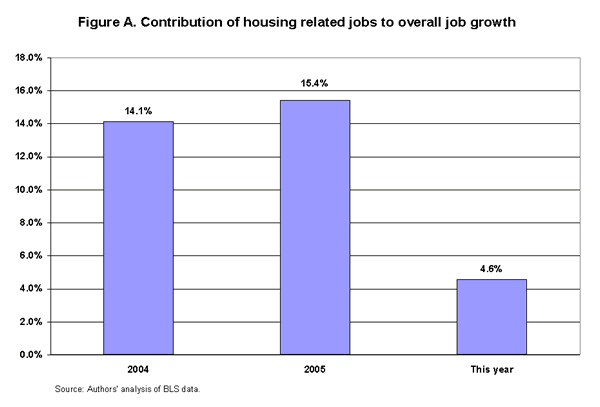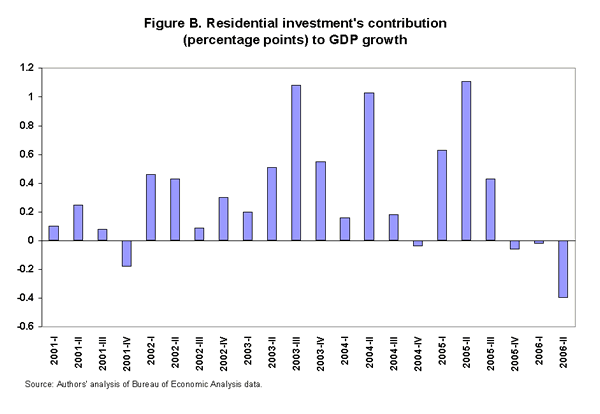See Snapshots Archive.
Snapshot for August 30, 2006.
The wide impact of the housing slump on the economy
by Jared Bernstein and L. Josh Bivens
A wide range of indicators reveal a sharp slowdown in the residential housing market. Sales of existing homes fell 11% over the past year after growing 9.8% in 2004 and 4.4% in 2005. New home sales are also well below last year’s level, and inventories (homes for sale on the market) are at record highs. With the increase in inventories along with diminished demand, prices are softening, especially in the hottest regional markets.
What impact might this slowdown have on the overall economy? In this Snapshot, we examine the relationship between a housing bust, jobs, and real GDP growth.
Housing is a “mid-stream” sector of the economy, meaning that many other industries, both upstream and downstream, are affected by the health of the housing market. For example, the demand for building materials increases in a booming housing market, as does the demand for appliances and furnishings. Even more important in terms of dollars pumped into the economy, is appreciated home values, which have been an important source of stimulus over the past few years.
Figure A shows the contribution of jobs generated by the housing sector to overall job growth. We include jobs in residential construction, but also real estate and credit intermediaries, like mortgage brokers (but not jobs related to demand for household goods). In 2004-05, these sectors—which represent about 6% of total jobs—contributed 14 and 15% of the growth in employment, respectively. Thus far in 2006, their contribution has been less than 5%.

Figure B looks at the contribution of the housing sector to the overall growth in real gross domestic product. Growth in the housing sector has contributed significantly to GDP growth over the course of the current recovery. Between the last business cycle peak (the first quarter of 2001) and the third quarter of 2005, residential investment contributed almost 0.4 percentage points each quarter to GDP growth on average, accounting for over 15% of the growth over this period. For the past three quarters, however, diminished activity in the sector has actually subtracted from growth. In the most recent quarter this subtraction was significant—knocking about 0.4% off that quarter’s growth.

Both figures reveal that the housing boom was a key contributor to the growth in both jobs and GDP over this recovery. It thus comes as little surprise that a slowing housing market creates a significant drag on the rest of the economy. Absent a considerable boost in demand from other sources (personal consumption, a lower trade deficit, or accelerated business investment), we can expect slower growth in coming quarters.
